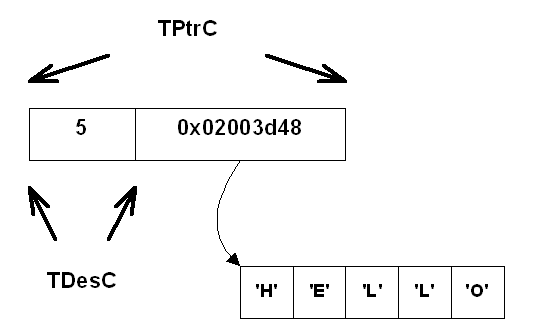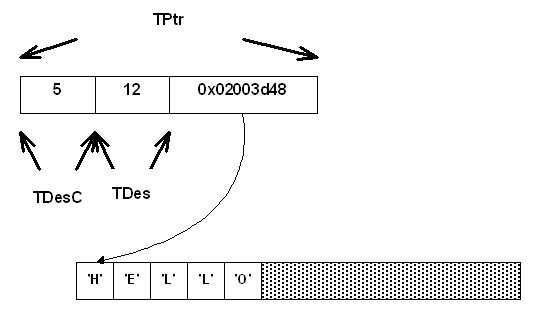Pointer descriptors
Describes non-modifiable pointer descriptors and modifiable pointer descriptors.
A pointer descriptor represents data which can live in ROM or RAM and this location is separate from the pointer descriptor object itself.
A pointer descriptor is an instance of a class that encapsulates a pointer to the location of the data.
A pointer descriptor comes in two forms:
Non-modifiable pointer descriptor
The data represented by a non-modifiable pointer descriptor can be accessed, but not changed, through this descriptor.
Data is accessed through functions provided by the base class.
A non-modifiable pointer descriptor is supplied in two variants:
the 16 bit variant, a
TPtrC16, for representing Unicode strings.the 8 bit variant, a
TPtrC8, for representing non-Unicode strings and binary data.
There is also a build independent type, TPtrC. This
is the type which is most commonly used in program code; the appropriate variant
is selected at build time.
An explicit 8 bit variant is chosen for binary data. The explicit 16 bit variant is rarely used.
The base
class, TDesC, contains a data member which holds the length
of the data. The following drawing shows the layout of a TPtrC object
for a string of five characters representing the English word "Hello".

Non-modifiable pointer descriptor
Modifiable pointer descriptor
The data represented by a modifiable pointer descriptor can be both accessed and changed through this descriptor.
The length of the data can vary between zero and the maximum length. The maximum length of the descriptor is set by the constructor. When the length of the data is less than the maximum, a portion of the data area represented by the descriptor is unused.
Data is accessed and modified through functions provided by the base classes.
A modifiable pointer descriptor is supplied in two variants:
the 16 bit variant, a
TPtr16, for representing Unicode strings.the 8 bit variant, a
TPtr8, for representing non-Unicode strings and binary data.
There is also a build independent type, TPtr. This
is the type which is most commonly used in program code; the appropriate variant
is selected at build time.
An explicit 8 bit variant is chosen for binary data. The explicit 16 bit variant is rarely used.
The base
class TDesC, contains a data member that holds the length
of the data. The base class TDes, contains a data member
that holds the maximum length of the data. The following drawing shows the
layout of a TPtr object for a string of five characters representing
the English word "Hello". The maximum length to be represented by the descriptor
is 12.

Modifiable pointer descriptor